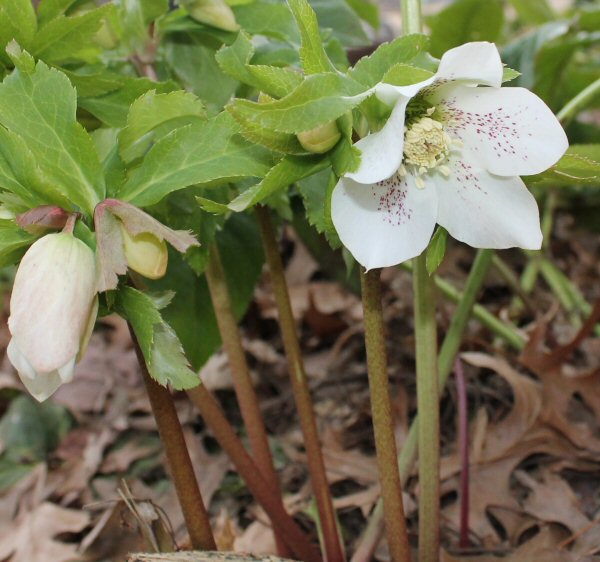February Plant of the Month: Hellebore

Hellebores, or Lenten Roses, are evergreen flowering plants that bloom when most plants are dormant. Photo by D. Stowell in the University of Tennessee Gardens in Knoxville.
Don’t let this plant’s name intimidate you. Hellebore is often called by several other less aggressive common names like Lenten Rose (Helleborous orientalis) and Christmas Rose (Helleborous niger). Despite having ‘rose’ in their name, they are not related to roses at all. Recent trends in hybridizing hellebores have brought gardeners more than 18 different varieties and a new Latin name, Helleborous hybridous.
Hellebores shine in the colder months. They are evergreen flowering plants that bloom when most plants are dormant and are great additions to any shade garden. You can find hellebores in most garden centers and they are growing in the UT Gardens, Knoxville, around the gazebo shade garden. In Jackson, they are prominent as well. The course-textured leaves provide interest throughout the year; however, their gift is their early blooming habit. Christmas Roses bloom earliest in this genus, and like the name alludes to, it often blooms around Christmas time.
Legend has it that a shepherd was on his way to Bethlehem to visit the newborn Christ child but did not have a gift to bring. On his way to Bethlehem the shepherd began to cry and tears fell on the ground. The Christmas Rose began to spring up where the tears fell and the shepherd was able to bring the flowers as a gift.
Hellebores originated in Eastern Europe and Asia and were traditionally used for treating aliments such as paralysis, gout, and mental health issues in early European medicine. However, many varieties are toxic and some historians attribute Alexander the Great’s death to a hellebore overdose.
The Lenten Rose gets its common name from the Christian calendar because they bloom during the time of Lent. The flowers appear in February and March and are signs of the approaching spring.
Hellebore flowers are long lasting, about three months from the start of blooming. Colors of the flowers range from white, light pink to deep purple. With the increasing of hybridization, you can find a variety of flowers including single blooms, double blooms and even bi-color blooms.
Hellebores are drought tolerant once they are established. A perennial that rarely needs dividing, hellebores are ideal for gardeners who like plants that require minimal fuss. They are also deer and rabbit resistant. One of the easiest ways to get more of these plants is to collect any seedlings that begin growing around mature plants. You can dig up these seedlings and plant them in other locations that have partial or full shade. It will take several years for the seedlings to flower. If you are keen to a particular color of flowers, you may prefer to purchase hellebores at a nursery when they are in bloom. This will guarantee you get the color of blooms you desire.
The blooms on hellebores often nod or face downward. Plant them on a hillside, in a raised bed or in a container to give you a better flower viewing angle. To add more interest, you can plant hellebores among other early spring-blooming plants like snowdrops and crocus. They also go well planted next to inpatients and ferns.
Hellebores tend to grow in clumps about 2 feet wide and 2 feet tall. When the foliage gets tattered and rough-looking in late winter you can cut them back. If you do this prior to blooming, it also will give you a better display of blooms. This easy-to-grow plant prefers a rich, well-drained soil. It should be planted in a partial shade to full shade location. Given all the positives of this plant, it is no wonder this plant was selected as the Perennial Plant Association’s 2005 perennial plant of the year.
Derrick Stowell plans and conducts educational programs for the University of Tennessee Gardens in Knoxville. The UT Gardens include locations in Knoxville and Jackson and are part of the UT Institute of Agriculture. Their mission is to foster appreciation, education and stewardship of plants through garden displays, collections, educational programs and research trials. The gardens are open during all seasons and free to visit. Some educational events are fee-based. See http://utgardens.tennessee.edu/ and http://westtennessee.tennessee.edu/ornamentals/ for more information.











